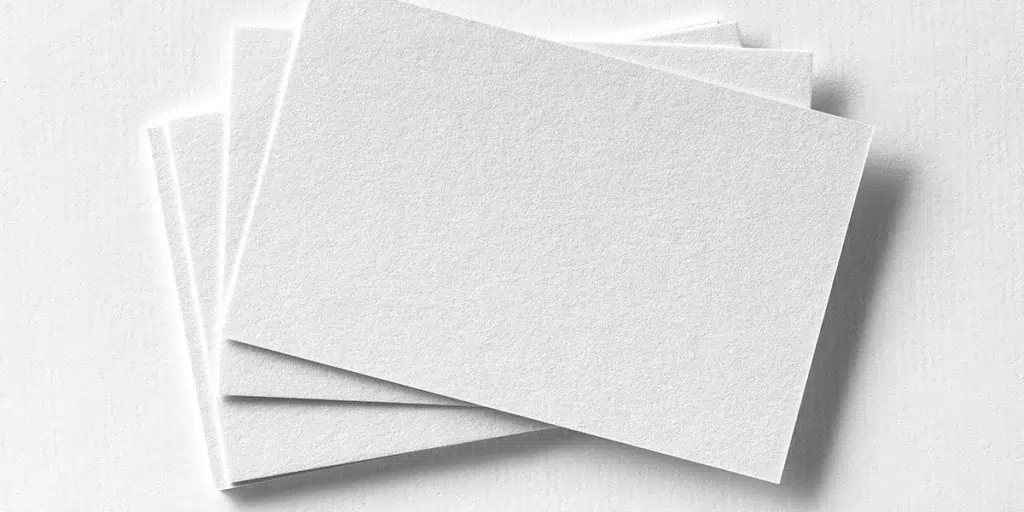
Do you know what business cards are and how to choose the right paper for your business cards? If not, let me tell you. For any professional or company owner, business cards are a crucial marketing tool. They can leave a lasting impression on prospective customers and partners and act as a physical reflection of your business.
The kind of paper you use for your business card design is an important factor to take into account. The correct paper can improve your cards’ overall appearance and feel, which will benefit the customers.
Moreover, we’ll provide you with comprehensive guidance on selecting the ideal material for your business cards in this article. Read it briefly if you are eager to find out.
Steps for Choosing the Right Paper for Your Business Cards:
1. Take into account the Paper Thickness:
The durability and impression of your business cards are greatly influenced by the thickness of the paper, sometimes referred to as the weight or stock. Thick cards provide a powerful impression because they feel more opulent and polished. Think about the picture you want to project and select a thickness that complements the identity of your company.
For firms who wish to project a sense of quality and longevity, thicker paper material is appropriate. It resists deterioration better than thinner alternatives and feels robust in the hand. But bear in mind that thicker cards could be less flexible and more expensive, which might have an impact on how well they fit into wallets or cardholders.
2. Select the Correct Finish:
The look and feel of your business card paper can be significantly influenced by the finish. Here are a few well-liked finishes to think about:
● Matte Finish:
This finish gives your cards a classy and beautiful appearance by providing a smooth, non-reflective surface. For organizations that like a traditional and subtle aesthetic, matte finishes are perfect. Additionally, they often resist smudges and fingerprints better, keeping your cards tidy and polished.
● Textured Finish:
Business cards with textured finishes, such as felt or linen, have a distinctive tactile quality. These finishes can make your cards stand out from the crowd and leave a lasting impact. Businesses in the luxury or creative sectors frequently select textured surfaces because they offer a sense of refinement and sophistication.
● Glossy Finish:
A glossy finish gives your business cards a dazzling covering that makes them look vivid and striking. Businesses that want a bright and contemporary look, such as those in graphic design, fashion, or photography, would love this finish. Glossy finishes can increase the visual impact of your cards by giving colours and graphics a more vivid appearance.
3. Take into Account the Color and Design:
Your business cards’ colour and design should go well with the paper you select. While darker papers sometimes need lighter or contrasting designs to maintain legibility, lighter-coloured papers go well with bolder or darker graphics. Choose a paper colour that complements the design components in your design while keeping in mind your brand’s overall look.
A white or light-coloured paper can give your minimalist or modern design, with its crisp lines and straightforward font, a polished and polished appearance. However, if the colour scheme of your business is more vivid and striking, you might want to think about using colourful paper options that go well with your design. Just make sure there is enough contrast for legibility between the text/logo and the paper.
4. Consider Environmental Factors:
Choosing eco-friendly paper options for your business cards can be a smart move in today’s environmentally conscious society. Seek out papers that are produced sustainably, or are composed of recycled materials. This demonstrates your dedication to sustainability and is also consistent with the ideals of your brand.
Options for recycled paper are becoming more and more common and accessible. Compared to papers created from different resources, they are less harmful to the environment because they are made from post-consumer waste.
5. Verify Before Printing:
You must test your selected paper on a small batch of business cards before committing to a large-scale run. That way, you know that the paper will live up to your standards in terms of look, robustness, and print quality. Testing also enables you to rectify any issues before printing more in bulk.
You can assess the paper’s performance with your preferred printing technique. Examining the paper’s ink retention, the text and graphics’ sharpness, and the extent to which the finish adds or subtracts from the overall design are all important considerations.
Conclusion:
In conclusion, selecting the appropriate material for your business cards is essential to making a good first impression and accurately showcasing your company. You can choose a paper that complements the overall appearance and feel of your business cards while being true to your brand’s identity by taking into account elements like paper thickness, finish, colour, design, and environmental impact.
To make sure you choose the finest solution for your business, take the time to test and investigate several possibilities before printing. Recall that using the proper material can improve your business cards and give the receivers something to remember you by.
